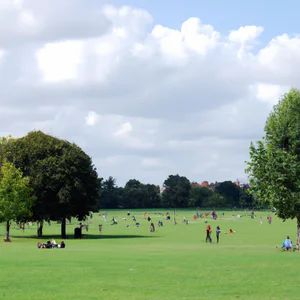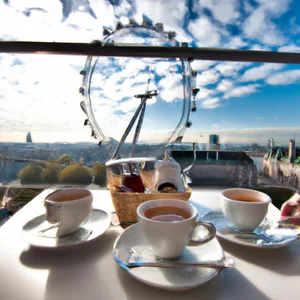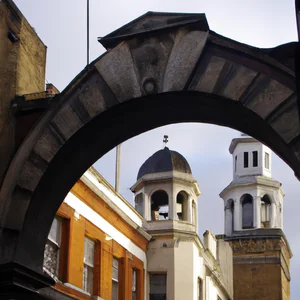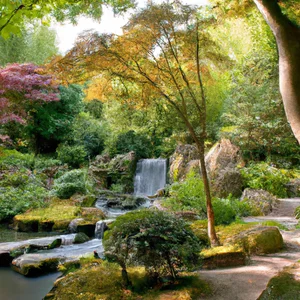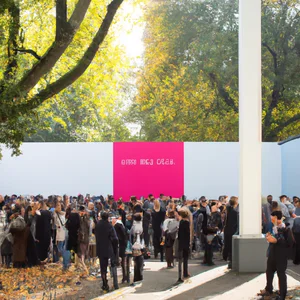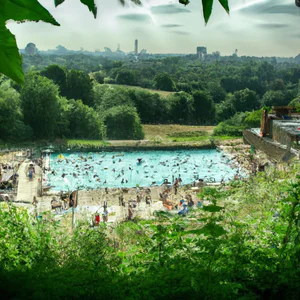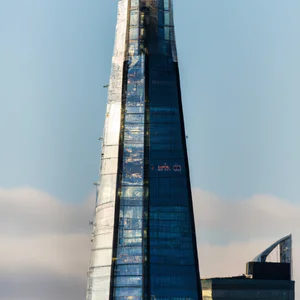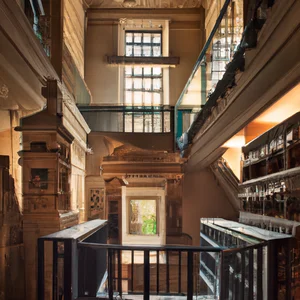Book your experience
One Canada Square: The skyscraper that kicked off the renaissance of Canary Wharf
One Canada Square, huh? That’s the skyscraper that practically restarted Canary Wharf, a place that, trust me, was a bit abandoned before. I remember when I went there for the first time, it almost felt like I was in a movie. The lights, the people running from one side to the other, and that skyscraper that stood out in the middle of everything, like a lighthouse in the middle of a storm.
So, let’s talk about this tower block. It’s as high as a dream you can’t forget. It was built in the early 90s, and from then on, things have changed crazy. Before, the area looked like a desert, but now? It has become a financial center teeming with life.
You know, I think there’s something fascinating about how one building can transform an entire neighborhood. It’s like when you put a pinch of salt in a bland dish: bam! Everything changes. And for Canary Wharf it was exactly like that. This skyscraper has attracted companies, career people and, oh, let’s not forget the many bars and restaurants that have sprung up like mushrooms after the rain.
Of course, it’s not all rosy. Some say the area has become too crowded and, well, a little expensive. But who can blame people for wanting to work in such a cool place? In short, One Canada Square is a bit like the beating heart of Canary Wharf and, if you think about it, without him, perhaps that place wouldn’t be anywhere near what it is today.
In conclusion, this skyscraper, with its imposing presence, has become a symbol of rebirth. And who knows, maybe one day I’ll go back, to see how it has changed again.
One Canada Square: Icon of modern architecture
A personal experience
I remember my first encounter with One Canada Square: a sunny afternoon, the sky clear and blue. As I approached, the towering silhouette of the skyscraper rose before me, its elegant lines and pyramid-shaped roof glimmering in the sunlight. This skyscraper is not just a building; it is a symbol of rebirth and innovation. At over 230 meters tall, it was the first skyscraper to exceed 200 meters in London, marking the beginning of a new era for Canary Wharf and transforming the skyline of the British capital.
Practical information
Opened in 1991, One Canada Square is not only an architectural icon, but also a vital center for business and culture. Today, it is home to numerous offices and offers public spaces that host events and exhibitions. If you wish to visit, I recommend checking the official Canary Wharf website for any special events or guided tours. The nearest tube stations, Canary Wharf and Jubilee Line, make this place easily accessible.
Unconventional advice
A well-kept secret is the Canary Wharf Crossrail Place Roof Garden, located a short walk from One Canada Square. This elevated garden, with its exotic plants and meandering paths, offers a peaceful retreat from the bustle of the city. It is the ideal place for a coffee break, away from the noise and frenzy of work.
Cultural impact
One Canada Square has had a significant impact not only on London’s architecture, but also on the work and lifestyle culture in the capital. It has attracted high-profile businesses and helped transform Canary Wharf into one of the world’s leading financial centres. The presence of this skyscraper has also stimulated the development of commercial and restaurant activities, creating a vibrant environment that attracts visitors and residents.
Sustainability
Canary Wharf is making strides towards sustainability, and One Canada Square is no exception. The skyscraper is designed to be environmentally friendly, with efficient heating and cooling systems and green spaces that help improve air quality. It is an example of how modern architecture can integrate with responsible tourism practices.
Vivid atmosphere
Walking around One Canada Square, the atmosphere is buzzing. Offices, restaurants and shops crowd the neighborhood, while people move with determination. The glass facades reflect the dynamism of urban life, and every corner seems to tell a story of progress and innovation.
An activity worth trying
Don’t miss the chance to go up to the rooftop bar The Drift, located near One Canada Square. Here you can enjoy a cocktail while taking in breathtaking views of the London skyline, an experience that further enriches your visit.
Myths to dispel
A common misconception is that Canary Wharf is an exclusive and inaccessible place. In fact, it is open to everyone, with numerous public events and welcoming spaces. Its liveliness is an attraction for anyone who wishes to discover a different London, far from the traditional tourist circuits.
Final reflection
When I look at One Canada Square, I see not just a skyscraper, but a symbol of what can come from challenge. Its presence invites us to reflect on how cities can reinvent themselves and thrive. What’s the next skyscraper that will inspire you to discover new stories and new perspectives?
History of Canary Wharf: From crisis to rebirth
A personal journey among the skyscrapers
I still remember the first day spent in Canary Wharf. Walking along the cobbled streets, I felt almost overwhelmed by the majesty of the skyscrapers soaring towards the sky. However, what struck me most was the vibrant atmosphere of an area that, just a few decades ago, was largely neglected. It is difficult to imagine that these imposing buildings, symbols of economic power and innovation, were born from the ashes of a profound crisis.
The transformation of a port area
In the 1980s, Canary Wharf was a declining port area, plagued by unemployment and urban decay. With the decision to transform the site into a financial centre, London embarked on an ambitious project that saw the construction of One Canada Square and many other skyscrapers. Today, Canary Wharf is one of the world’s leading financial districts, hosting the headquarters of many banking institutions and global companies. Local sources, such as the Canary Wharf Group, highlight that the rebirth of the area has not only revitalized the economy, but has also created a new model of urban development.
An insider tip
If you really want to understand the evolution of Canary Wharf, I recommend you visit the Museum of London Docklands. This museum not only offers a historical overview of the area, but also features interactive exhibits that chronicle the transformation from a trading port to an economic hub. Many tourists overlook it, but it’s a hidden gem that offers a unique perspective on local history.
The cultural and historical impact
The rebirth of Canary Wharf has had a significant impact not only on the economic landscape, but also on the cultural life of the city. Today, this district is a crossroads of innovation and creativity, with public spaces hosting cultural events, markets and art installations. The transformation has also stimulated an ongoing debate on sustainability and social responsibility in the context of urban development.
Sustainable practices and responsible tourism
Canary Wharf is not only an example of economic success, but also a model of sustainability. The area is equipped with large green spaces and eco-friendly practices, such as the recycling of rainwater and the use of renewable energy. During your visit, try to explore on foot or by bicycle, thus helping to reduce your environmental impact and discover lesser-known corners.
An experience not to be missed
During your stay, don’t miss a stroll through the Canary Wharf Crossrail Place Roof Garden. This roof garden offers spectacular views of the skyscrapers surrounding areas and is the ideal place for a relaxing break. You’ll even be able to participate in free events that take place frequently, a perfect way to immerse yourself in the local community.
Dispelling the myths
Canary Wharf is often thought to be exclusively a center for business and finance, but in reality it offers much more. The area is full of restaurants, bars and cultural spaces, making it a lively destination even for those who don’t work here. It is a place where the modern merges with history, and every corner tells a story of resilience and innovation.
Final reflection
The story of Canary Wharf is a testament to a city’s ability to reinvent itself and thrive. As you explore this district, ask yourself: How can we apply the lessons learned from this resurgence to other troubled areas around the world? The answer may turn out to be closer than you think.
Unique experience: Café with panoramic view
Imagine sipping a creamy cappuccino, as the sun sets over the London skyline, painting the sky in shades of orange and pink. This is the kind of experience you can have at One Canada Square, the landmark of Canary Wharf. The first time I visited one of the rooftop cafes here, I was fascinated by the breathtaking view: the skyscrapers rising against the sky, the River Thames flowing peacefully and the city lights starting to twinkle. It is a moment that remains etched in the memory, a perfect balance between modernity and natural beauty.
Practical information
Numerous cafes and restaurants at One Canada Square offer not only a great selection of drinks, but also the chance to enjoy terraces overlooking one of the most iconic skylines in the world. Among the most recommended options are Brewed by Brand and The Pearson Room, both known for their welcoming atmosphere and creative menus. It is always best to check the opening hours, as they may vary depending on the season and ongoing events. You can check the official Canary Wharf website for the most up-to-date information.
Insider tip
If you want a truly unique experience, try visiting during the local workers’ lunch break. Not only will you have the opportunity to enjoy fresh, freshly prepared dishes, but you will also be able to observe the lively pace of London working life. Many of the cafes offer special promotions during this time, so don’t forget to ask!
Cultural and historical impact
The choice to create public spaces such as cafes and restaurants at One Canada Square has had a significant impact on the culture of Canary Wharf. These places are not only eateries, but also meeting spaces for professionals, artists and visitors, contributing to a sense of community in an area otherwise dominated by offices and commercial activities. The renaissance of Canary Wharf has demonstrated that even the most modern areas can host rich and varied cultural experiences.
Sustainable tourism
Many of Canary Wharf’s cafes are committed to sustainable practices, using local ingredients and reducing waste. Opting for a café that follows these principles not only enriches your experience, but also supports the local economy and green initiatives in the area. Don’t hesitate to ask about the origin of the ingredients when you order!
An experience not to be missed
When visiting Canary Wharf, be sure to make time for one of the cafes with a view. Not only will you be able to enjoy a great drink, but you will also have the opportunity to immerse yourself in a vibrant and cosmopolitan atmosphere. I recommend you try the tea time; many cafes offer delicious desserts and snacks that pair perfectly with your tea or coffee.
Myths and misconceptions
It is often thought that Canary Wharf is just an area for business people, but in reality it is a place rich in history and culture, with unique experiences to offer. Cafés with panoramic views are tangible proof that even in a modern urban context, you can immerse yourself in the beauty of daily London life.
In conclusion, I invite you to reflect: what would be your ideal drink to sip with such a spectacular view? Whether it’s a simple coffee or a sophisticated sunset cocktail, the possibilities are endless.
The best things to do in Canary Wharf
When I visited Canary Wharf for the first time, I felt like I had entered a world apart. The imposing glass and steel structures, which stand like modern sculptures, create a vibrant and dynamic atmosphere. But beyond its iconic architecture, this neighborhood offers a variety of experiences that go far beyond just shopping and office work.
Discover the mix of culture and entertainment
One of the activities that impressed me the most was the walk along the River Thames. The pedestrian areas are well maintained, and as I walked, I could admire the contrast between nature and modernity. The benches overlooking the water are a great place for a break, where you can watch the barges sailing by and the skyscrapers reflecting in the water.
For those looking for a more active experience, the Canary Wharf Fitness Trail is an excellent option. It is a 3.5 km jogging route that runs through the neighborhood, enriched by exercise equipment and green areas where you can stop to rest. It’s a fantastic opportunity to combine health with tourism.
An insider tip
If you want a little-known experience, I recommend visiting the Crossrail Place Roof Garden. This hidden garden, located above the train station, is a slice of paradise with plants from all over the world. Here you can enjoy a quiet moment surrounded by lush greenery and, if you’re lucky, you might even come across live events or concerts held frequently.
A significant cultural impact
Canary Wharf is not just a financial centre; it is also a growing cultural node. Art events and temporary installations are spreading throughout the neighborhood, bringing a touch of creativity to the otherwise staid setting. This change has made Canary Wharf a place where culture and art intertwine with everyday life, making the area more accessible and interesting for visitors.
Sustainability and responsibility
In an age where sustainability is key, it’s interesting to see how Canary Wharf is embracing eco-friendly practices. Gardens and green spaces not only beautify the area, but also help improve air quality and local biodiversity. Participating in green events or simply walking or cycling around the neighborhood is one way to contribute to this commitment.
An experience not to be missed
Don’t miss Canada Square Park, where you can relax on one of the many lawns or take part in events held throughout the year. The sight of the dancing fountains and people having fun is a great way to soak up the atmosphere of Canary Wharf.
Let’s dispel some myths
A common misconception is that Canary Wharf is just an area for business people. In reality, it is a lively and vibrant place, full of activities for families, couples and individuals. The variety of restaurants and cafes offers options for every palate, and cultural events are rapidly changing the perception of this neighborhood.
A final reflection
Next time you think of Canary Wharf, ask yourself: how can such a modern and industrial area also offer a haven of nature and culture? The answer is simple: through the fusion of architecture, art and sustainability, this neighborhood is redefining what it means to live and work in the city. What a Canary Wharf experience Does it fascinate you more?
Sustainability in Canary Wharf: A model to follow
A personal experience of connection
I still remember my first visit to Canary Wharf. As I walked among the modern skyscrapers, I was struck by the amount of greenery present in this financial district. I didn’t expect to find such well-kept hanging gardens and green areas in such a frenetic urban context. It was at that moment that I began to understand how sustainability had become an integral part of the DNA of this place.
A tangible commitment to the environment
Canary Wharf is not just a financial centre; it is also a shining example of how urbanization can be achieved responsibly. The area has adopted significant green practices, such as the use of sustainable materials in construction and the integration of green spaces. According to the Canary Wharf Group, more than 30% of the area’s surface area is dedicated to gardens and open spaces, a commitment that not only improves air quality but also provides a haven for biodiversity.
An insider tip
If you would like to discover Canary Wharf’s commitment to sustainability, I recommend taking one of the guided tours organized by the Canary Wharf Group. During these tours, you will have the opportunity to explore not only the modern architecture, but also the eco-friendly initiatives and green technologies implemented in the neighborhood. Also, don’t forget to visit the Crossrail Place Roof Garden, an oasis of tranquility that hosts plants from all over the world and offers a unique view of the London skyline.
The cultural impact of sustainability
Canary Wharf’s choice to invest in sustainability has a lasting cultural impact. Not only does it promote a positive image of the neighborhood, but it also inspires other cities to follow its example. This approach has helped create a more aware and engaged community, where citizens and visitors are encouraged to reflect on the importance of sustainability in everyday life.
Responsible tourism practices
If you are planning a visit to Canary Wharf, consider using public transport to reach the area. London’s transport network is well developed and allows you to reduce your carbon footprint. Furthermore, you can opt for restaurants that use local and seasonal ingredients, thus contributing to the local and sustainable economy.
A vibrant and welcoming atmosphere
As you walk the streets of Canary Wharf, let yourself be enveloped by the vibrant and modern atmosphere. People rushing to their destinations, the sounds of conversations in outdoor cafes and fresh air flowing between buildings create a unique experience. It is a place where the future of sustainability intertwines with everyday life, making it an example to follow.
A myth to dispel
A common misconception is that Canary Wharf is just an area for business people and offers nothing else. In reality, the area is a melting pot of cultures, events and initiatives that involve the community. From live music in the parks to arts and culture events, there’s always something to discover.
A final reflection
After exploring the greenest corners of Canary Wharf, I invite you to reflect: how can we integrate sustainable practices into our daily lives, taking inspiration from places like this? Sustainability is not just a question of policies, but a way of living that it can transform our cities into more livable and harmonious spaces.
Public Art: Discover hidden treasures
An unexpected encounter
I still remember the moment I came across a bronze sculpture, several meters high, hidden in a quiet corner of Canary Wharf. As I walked along the modern streets, surrounded by glittering skyscrapers and futuristic architecture, that statue caught my attention. It was a bold and intriguing depiction that seemed to tell a story of resilience and creativity. This chance encounter opened my eyes to the incredible public art that permeates this area, something many visitors overlook.
An evolving artistic panorama
Canary Wharf is not just a financial centre; it is also a real open-air museum. With over 100 works of art spread across the district, including installations by internationally renowned artists such as Henry Moore and Isamu Noguchi, every corner holds a surprise. The sculptures, murals and temporary installations intertwine with urban planning, creating a fascinating contrast between art and modern architecture. For an authentic experience, you can download the ‘Canary Wharf Art Trail’ app, which offers guided tours and detailed information on each work.
An insider tip
A little-known tip: don’t forget to visit Cabot Square, especially at sunset. The golden light reflecting on the sculptures creates a magical atmosphere. Plus, if you’re lucky, you might come across pop-up art events or live performances taking place on weekends.
Art as a mirror of the community
The cultural impact of public art in Canary Wharf is significant. These works not only beautify urban space, but also tell the story of an ever-evolving community. Art here is a way to promote dialogue and connection between people, offering a sense of belonging in an environment otherwise dominated by commercial activity.
Sustainability in art
In an age where sustainability is paramount, many of the art installations are made from recycled or sustainable materials. This approach not only minimizes environmental impact, but also invites visitors to reflect on the link between creativity and sustainability.
An experience not to be missed
I recommend you take part in one of the organized guided tours, where local experts will tell you intriguing anecdotes and guide you through the hidden treasures of the district. Don’t forget to bring your camera - every corner of Canary Wharf has something unique to capture.
Myths to dispel
A common misconception is that public art in Canary Wharf is only for art lovers. In reality, these works are accessible to all and offer an interesting opportunity to discover local history and contemporary creativity. You don’t need to be an expert to appreciate the beauty and meaning of these installations.
A new perspective
After exploring the public art of Canary Wharf, I asked myself: how can art transform the way we live and interact in an urban environment? This reflection pushed me to see art not just as a aesthetic expression, but as a powerful tool for connection and social transformation. I invite you to consider this perspective during your visit, discovering the hidden treasures of this vibrant London borough.
Local cuisine: Restaurants not to be missed
A taste of Canary Wharf
I still remember the first time I set foot in Canary Wharf. After taking in the majesty of One Canada Square, my stomach started growling, and I decided to explore the local food scene. I entered a restaurant called The Pearson Room, with a breathtaking view of the River Thames and an atmosphere that combined elegance and hospitality. Here, I enjoyed a fresh seafood dish that literally danced on my palate, an experience that turned my stay into an unforgettable journey.
Where to eat in Canary Wharf
Canary Wharf is a true culinary paradise, with a variety of restaurants offering dishes from around the world. Here are some of the best not to be missed:
- Roka: Specializing in Japanese cuisine, it is famous for its robatayaki and sushi very fresh.
- Gaucho: If you love meat, this Argentine restaurant is a must. The steaks are cooked to perfection and accompanied by a selection of exceptional wines.
- Bokan: Located on the 37th floor, offering a dining experience with a view, where every dish is a celebration of modern British cuisine.
Unusual advice
If you want a truly unique dining experience, I recommend trying the pop-up restaurant that occasionally takes place in the Canary Wharf Market. Here, local and emerging chefs present innovative dishes using fresh, seasonal ingredients. It’s a great way to discover new talent and enjoy delicious food at affordable prices.
Cultural and historical impact
Canary Wharf’s food scene is a reflection of its evolution from an industrial area to a modern financial and cultural centre. This change has brought greater culinary diversity, attracting chefs and restaurateurs from all over the world and enriching the city’s gastronomic offer.
Sustainability and responsibility
Many restaurants in Canary Wharf are embracing sustainable practices, such as using local and organic ingredients. Restaurants like The Ivy have implemented programs to reduce waste and promote the use of farm-to-table products, making their offering not only delicious, but also responsible.
Immerse yourself in the atmosphere
Imagine sitting outdoors, with a light breeze caressing your face as you sip a craft cocktail and savor a plate of tapas from Dalloway Terrace. The lively atmosphere of Canary Wharf, with its mix of modernity and history, will make you feel like part of a large urban fresco.
An experience worth trying
During your visit, don’t miss the opportunity to participate in a guided food tour. These experiences will take you to the most authentic restaurants and markets, allowing you to savor local flavors and learn the stories behind each dish.
Myths to dispel
A common misconception is that Canary Wharf is only for business people and that its food scene is limited. In fact, the variety and quality of restaurants reflect a wide range of cultures and culinary styles, making it an appetizing destination for all.
A final reflection
As you explore the restaurants of Canary Wharf, ask yourself: How can the food we choose to eat reflect our connection to the culture and community around us? The next time you find yourself in front of a delicious dish, remember that every bite tells a story of tradition and innovation.
Unusual tip: Explore neighborhood markets
Do you visit Canary Wharf and think everything is contained in its glittering skyscrapers and luxury shops? I invite you to discover a lesser-known side of this area, where the pulse of daily life intertwines with modern architecture. As I admired One Canada Square from its vantage point, a local friend revealed a hidden treasure: the neighborhood markets.
The treasures of the local markets
Just steps away from the bustling financial heart, you’ll find markets like Poplar Market and Limehouse Market, where local vendors offer fresh produce, crafts and culinary delights. Here, time seems to slow down; the atmosphere is lively and welcoming, and you can taste the authenticity of a London that often escapes tourists. It’s not uncommon to come across a chat with the vendors, who are always happy to share stories and recipes.
An insider tip
If you want a truly unique experience, visit Limehouse Market on Saturday mornings. Not only will you find fresh produce and local ingredients, but you will also have the opportunity to participate in a traditional cooking workshop. This is a perfect way to immerse yourself in the culinary culture of the area and return home with new skills.
Cultural impact and sustainability
These markets aren’t just places to shop; they are community centers that promote sustainable consumption practices. Many vendors are committed to using locally sourced ingredients and organic offerings, thus contributing to a circular economy. Supporting these markets also means supporting local families and traditions, a gesture that has a positive impact on the community.
A unique atmosphere
Imagine walking among the stalls, surrounded by the bright colors of seasonal fruit and vegetables, while the scent of freshly cooked food fills the air. It’s a charming contrast to the modern architecture of One Canada Square, which stands majestically in the background. Here, modernity coexists with tradition, creating an atmosphere that is both dynamic and welcoming.
Myths to dispel
Many think that Canary Wharf is just an area for business people, but these markets show that there is much more. They are spaces where the community gathers, where families meet, and where visitors can truly experience the soul of London. Don’t let the glossy image of this district fool you; its beating heart is to be explored.
Final reflection
After exploring these markets, I invite you to reflect: how important is it for us, as travelers, to immerse ourselves in local cultures? Let your Canary Wharf experience go beyond the skyscrapers and discover the warmth and hospitality of its communities. The next time you find yourself in front of One Canada Square, remember that behind its grandeur lies a vibrant and authentic world, ready to be explored.
Cultural events: Experience Canary Wharf like a local
A surprising experience
A couple of years ago, I found myself in Canary Wharf for work, an experience that opened my eyes to how alive and dynamic this area is. I was initially sceptical, thinking of Canary Wharf only as a financial centre, but as evening fell, when the lights of the skyscrapers began to shine, I discovered a completely different side. At that moment, I realized that the true beating heart of the area manifests itself through its cultural events.
A calendar full of offers
Canary Wharf isn’t all about business; it is also a melting pot of culture. Every year, the area hosts a variety of events, from music festivals to craft markets to outdoor art exhibitions. For example, the Canary Wharf Jazz Festival is an unmissable event for music lovers, while the Art in the Park offers an excellent opportunity to discover local artists. To stay up to date, I recommend checking the official Canary Wharf website, where you can find a complete calendar of events.
An insider’s secret
If you want to experience Canary Wharf like a local, don’t miss the Greenwich Peninsula Market, which takes place every Sunday. Here you can savor delicious dishes from all over the world and discover unique artisan creations. The great thing is that this market is often overlooked by tourists, allowing you to immerse yourself in an authentic and convivial atmosphere.
A significant cultural impact
The rebirth of Canary Wharf has had a profound impact on London culture. From an area of little interest, it has become an attractive center not only for business, but also for art and the community. Events such as the Winter Lights Festival, where luminous artistic installations animate public spaces, demonstrate how culture can transform a place and make it accessible to all.
Sustainability in focus
In an age where sustainability is key, Canary Wharf is actively working to reduce its environmental impact. Many events are organized with eco-friendly practices, such as the use of recyclable materials and the promotion of sustainable transportation. Participating in these events also means supporting a model of responsible tourism.
An invitation to explore
For those visiting London, I suggest spending a few hours exploring the cultural events of Canary Wharf. Not only will you enrich your travel experience, but you will also have the chance to meet local people and discover stories that would otherwise remain hidden.
Final reflection
Have you ever thought about how a simple cultural event can change your perception of a place? Next time you find yourself in Canary Wharf, stop and observe for a moment; you may discover that beneath the surface of a financial center, there is a vibrant, pulsating soul just waiting to be explored.
How One Canada Square changed London
An unforgettable meeting
I still remember the first time I set foot in Canary Wharf, gazing at the majesty of One Canada Square. This tower, with its 235 meters of height, is not just a skyscraper; it is a symbol of a London that has been able to reinvent itself. While sipping a coffee in one of the many bars on the ground floor, I felt the pulse of a city in constant motion, the perfect fusion of the modern and the traditional. The view from the window, with the Thames flowing placidly under the sun, made me reflect on the importance of this place in the transformation of London’s urban landscape.
History and impact
Built in 1991, One Canada Square represented a turning point for Canary Wharf and for the entire British capital. After the economic crisis of the 1980s, this once neglected area became a pulsating financial centre, attracting international companies and investment. According to the London Development Agency, the skyscraper has helped generate over 100,000 jobs in the area, revitalizing the local economy and forever changing the perception of London as a global city.
Insider tip
A little-known tip is to visit the public plaza of One Canada Square during sunset hours. Here, the play of light and shadow creates a magical atmosphere, perfect for a romantic walk or to simply reflect on the architectural beauty that surrounds us. Furthermore, not everyone knows that the square regularly hosts cultural events and free concerts, offering a unique experience to visitors.
The evolving culture
The cultural impact of One Canada Square goes beyond its physical structure. He inspired a new generation of architects and designers, contributing to a renewed interest in contemporary architecture in London. The presence of public works of art and artistic installations in the surrounding area has further enriched the area, making it a cultural reference point for residents and tourists.
Sustainability and responsibility
In an age where sustainability is key, Canary Wharf is making significant strides. One Canada Square has implemented practices to reduce environmental impact, such as stormwater management systems and the use of renewable energy. Visiting this place also means embracing responsible tourism, which takes into account the needs of the environment.
An experience not to be missed
For an unforgettable experience, I recommend booking a guided tour of the tower. This will give you not only the opportunity to explore the magnificent interior, but also to hear fascinating stories about its construction and the role it played in the rebirth of Canary Wharf.
Myths to dispel
A common myth concerns the perception of Canary Wharf as an exclusively commercial and impersonal area. In reality, despite its status as a financial centre, the area is alive with cultural events, markets and green spaces, which make it accessible and welcoming for all.
Final reflection
As I watched One Canada Square soar into the London sky, I realized that this skyscraper isn’t just a building; it is a symbol of resilience and innovation. Have you ever wondered how a single building can change the identity of an entire city? Next time you visit London, take a moment to reflect on how your experience may be influenced by these architectural wonders.

 Architecture and Design
Architecture and Design Cities and Regions
Cities and Regions Culture and History
Culture and History Events and Festivals
Events and Festivals Fashion and Shopping
Fashion and Shopping Food and Wine
Food and Wine Nature and Adventure
Nature and Adventure Unique Experiences
Unique Experiences




















